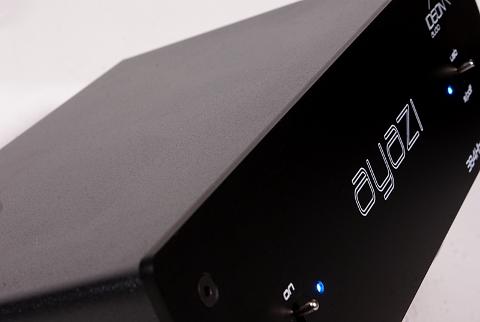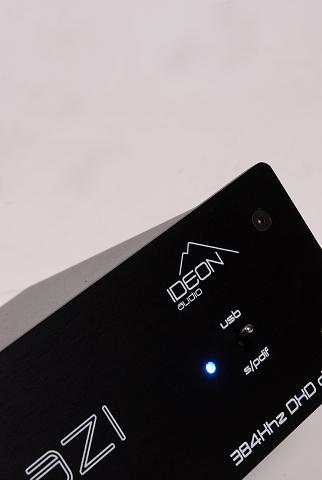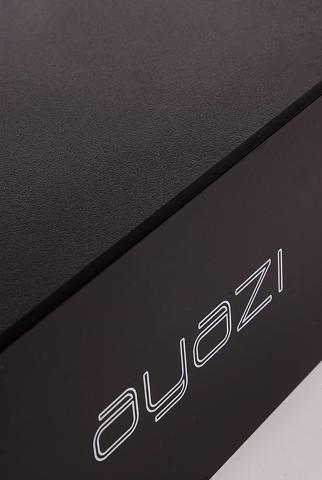about Audio, High Fidelity
& Home Entertainment technologies
pid: 607-2025/10/01 (v1.2)
Privacy Policy

During the listening sessions, Ayazi was connected through both its standard S/PDIF coaxial digital input and its USB port. For the former, our reference CD transport (Teac Esoteric P70 with no upsampling) was used as a source while, for the latter, our usual computer-streaming setup (Win7, foobar2000) was connected to the DAC. The rest of the system included the Melos Plus Series Line preamplifier, the Parasound HCA3500 power amp, and the ATC SCM50 PSL loudspeaker.
To use Ayazi as a USB DAC in Win7, the installation of a driver is required which the user can download from the Ideon's website. The installation was done without any problems, and the system worked as expected, from the start. In addition to the driver installation, Ayazi does not require any special attention during its initial setup. In fact, from the moment you get it out of the box, it takes just a few minutes to have it up and running and its compact dimensions will make the user's life even easier.
The first impression one gets from listening to the converter is that of a sonically pleasant device, easily distinguished for its neutrality and its ability to highlight the details of a recording. With the Ayazi as a DAC, the system has maintained its very good capacity for stereo imaging, with a clearly defined soundstage, a feeling of homogeneity, a good sense of scale and extension and very good dynamic characteristics. The general impression one gets by listening to Ideon's DAC for the first time is that the company aimed for an accurate result from the beginning and tried to approach sonic neutrality and the "absence" of the device. This was an objective that was achieved since the listener cannot identify a dominant sound character originating from the DAC.
The very low-frequency part of the audio spectrum featured good detail and accurate size description, with a good feeling of air and a relaxed character. Recordings with serious content in this specific range, sounded impressive without being excessive, while the device appeared to be transparent. There was no "character" imposed to the final result, in an effort to indulge the listener, but only the music details included in the recording. The system, with Ayazi as its DAC, maintained its good low-frequency balance while the strict control to which I was accustomed to (by listening to the reference Teac Esoteric D-70 DAC), appeared to be somewhat more relaxed. Nevertheless, the beat and the feeling of size and scale of the musical instruments, both electronic and acoustic, remained more than satisfactory, contributing to an accurate end result. Upper bass remained fast and lightweight, without being muddy or oversized, giving a well detailed and balanced sense of "order", particularly in the rhythm section, with highly detailed percussive sounds. Ayazi proved very good in microdynamics (i.e in the description of music transients), an attribute which ideally complemented its low-frequency presence, the result offering the listener an easily obtainable foot-tapping emotion.
Midrange rendering is one of Ayazi's most powerful aspects. The converter easily wins the listener with its vibrancy and well-balanced brightness, while he or she remains placed at the right distance, neither too far away (offering a more atmospheric, sui-generis perspective) nor to close (imposing an overwhelming "over-analytic" feeling). In this respect, Ayazi despite its much lower price was -indeed- quite close both to the reference DAC (Teac Esoteric D70) and to devices in a much higher price range.
Along with the midrange, the stereo imaging in general and the feeling of space, in particular, proved to be the most compelling parts of the sound character of the device. The soundstage appeared very clear, stable and extremely good both at focusing individual sound sources in space and defining whole musical instruments groups (especially in large orchestra recordings), with a good description of sound source movement and a good feeling of air. Combined with some top-quality high-definition recordings and a system with a similar capacity in stereo imaging, Ayazi was able to create some outstanding results. Against this background, it is certainly not surprising that the human voice, choir or solo, appeared particularly realistic both in timbre and articulation and, also, well focused, with the soloists and the chorus offering a good sense of proportion and scale. Moreover, it was quite impressive that Ayazi always remained transparent and invigorating, without any trace of compression, despite the abundance of information contained in many of the recordings.
The high-frequency part of the spectrum was characterized by a very good feeling of extension and was well balanced without being neither soft nor harsh. In fact, the converter seemed quite capable of routing all the high-frequency details and nuances through the rest of the system and to the loudspeakers, and this is a very good starting point to enjoy the features of high-resolution audio. Attack and release parts were much more than just satisfactory, with the former being quite fast and with a feeling of clarity and good definition and the later being well arranged and detailed even at low levels. One point which differentiates Ayazi in comparison with the reference DAC is a subtle emphasis on the body of high-pitched percussion instruments, which -however- is neither unpleasant nor excessive in its presence. This behavior, combined with a good feeling of harmonic richness, seems to offer the converter a just perceivable dark character side (which, probably, is something planned during Ayazi's voicing), thus the converter will never be too bright or aggressive in this frequency range.
In retrospect, it seems that all the basic attributes that define Ayazi's sound behavior point to a device that is particularly suitable for high-resolution audio streaming. Although listening to some good-quality standard resolution material is sufficient to realize the DAC's core values, a higher bitrate recording confirms the impression that Ayazi gives its best when a higher audio information throughput is needed. Ideon Audio's converter managed to maintain the system's very good dynamic behavior (probably because of its good noise performance) and its ability to describe complex mixes, while fashioned a relaxed feeling that is so characteristic of higher sampling rate audio playback. It is, certainly, quite difficult to say if this is a design aspect in the first place or just the positive side-effect of a judicious design approach, but it is a fact, anyway.
Conclusion
It is fair to say that this first product from Ideon Audio exceeded our expectations in many ways, featuring a quite pleasant and balanced sonic behavior, with emphasis on accuracy and detail, both basic requirements for a converter capable of high-resolution audio playback. These findings constitute by themselves strong evidence that Ayazi ranks among the best D/A converters we have reviewed in this price range and place the device near the top of a wish-list, a fact important for any newcomer. The legacy Ayazi creates is, however, equally important: Vasilis Tounas proved that he has the ability to make choices and trade-offs and to set priorities. His rather thrifty but not simplistic approach to this design, proved highly successful and leaves open a question to be answered: What should we expect from a higher spec'd device? We will wait.
Listening Sessions Recording
The following recordings were made with a DV-RA1000 Tascam master recorder (using 24bit/192kHz sample rate) and you can download them to have an impression of what the device under review sounded like. It is obvious that any recording of this kind could not be absolutely transparent but, according to our experience, the majority of sound attributes we listen to, during the actual listening sessions, are preserved. No need to say that you should use these samples cautiously and for informative purposes only. Do not rely on them exclusively to make any buying decisions. The file format is .flac, so expect that the zipped files will be quite large (even if the clips are about a minute or less long. You could use an ABX listening tool like the ABX plug-in for foobar2000 if you want to make some more elaborate experiments. Contact us if you have any questions.
| Listening Sessions Recording TOC | |
|---|---|
| Track #01 | Ideon Audio Ayazi, USB, 16bit/44.1kHz. |
| Track #02 | Ideon Audio Ayazi, USB, 24bit/96kHz. |
| Track #03 | Reference: dCS Puccini u-Clock/Teac Esoteric D-70. |
Previous | Next | More Reviews



